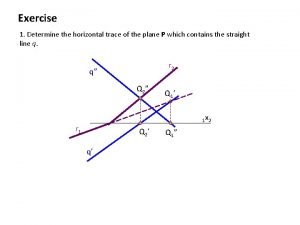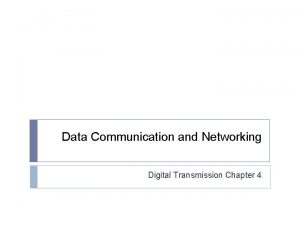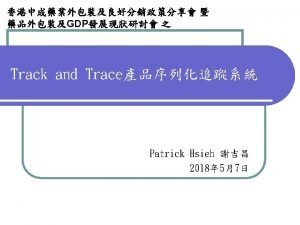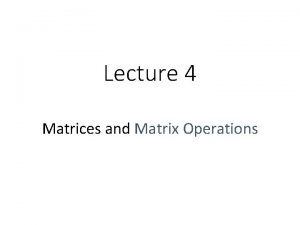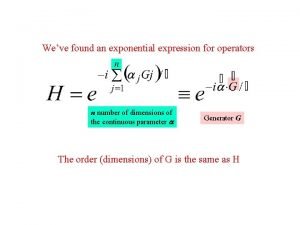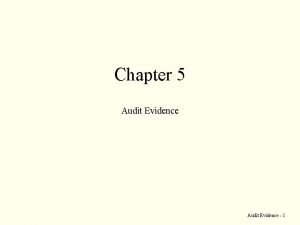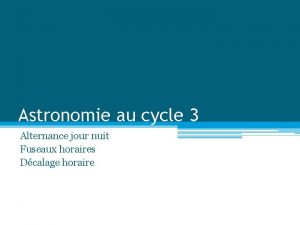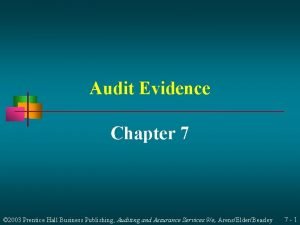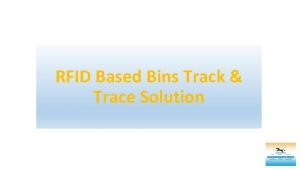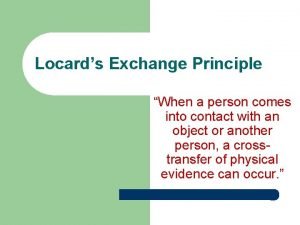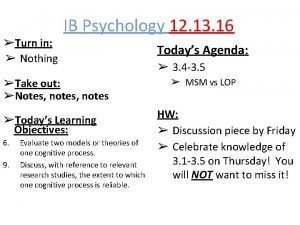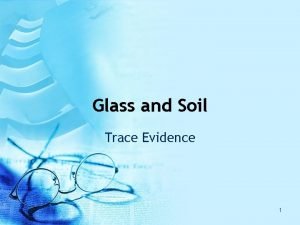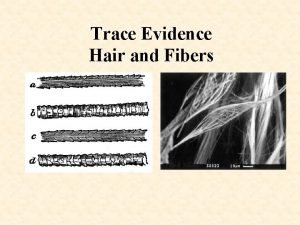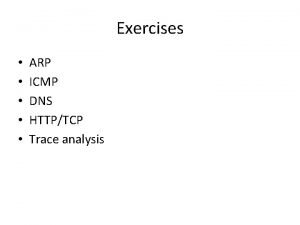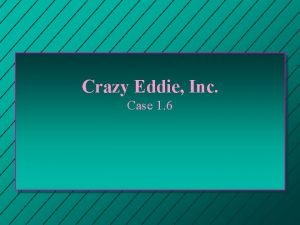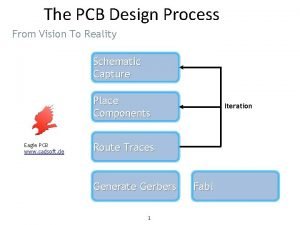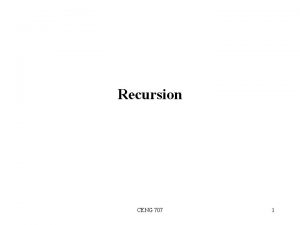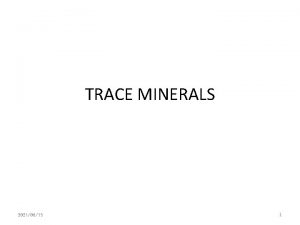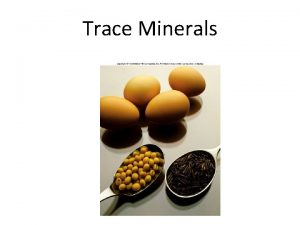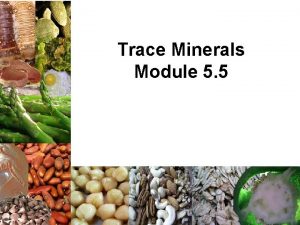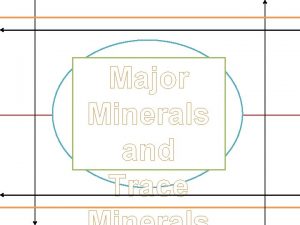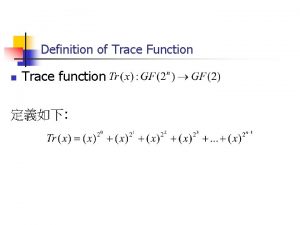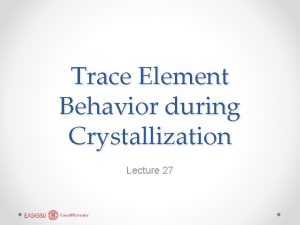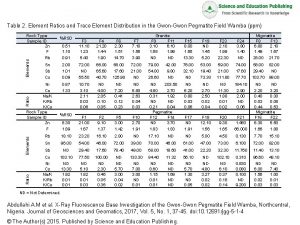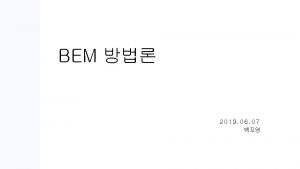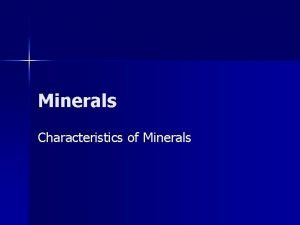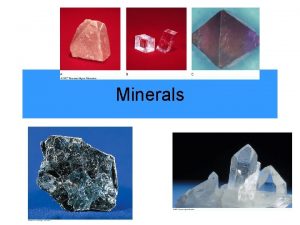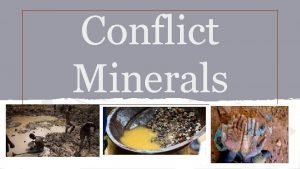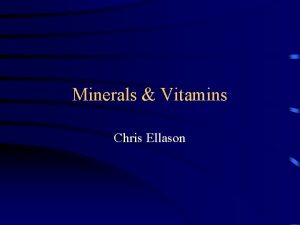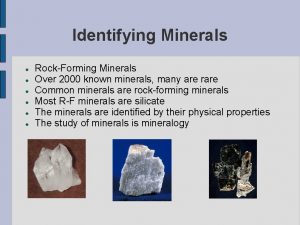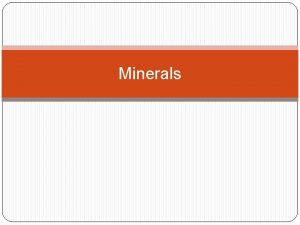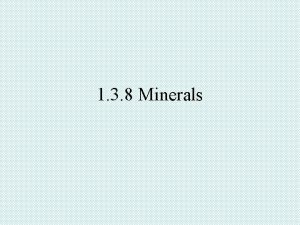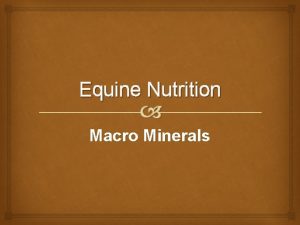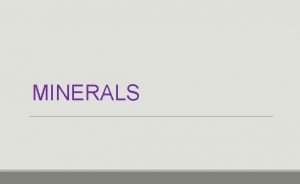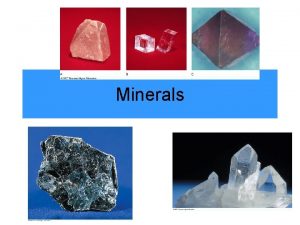Trace Element Minerals Minerals Minerals are required in


















































- Slides: 50

Trace Element Minerals

Minerals • Minerals are required in human diet for optimal body function. • All minerals are essential. • Both deficiencies and excess of minerals can cause disease.

Iron • Total body iron is : 2 -2. 5 g in females. 3 -3. 5 g in males. • Majority of iron is present in hemoglobin. • Small amount present in cytochromes and myoglobin

Sources and daily requirements • • Daily requirement : 8 mg Sources : red meat, liver, green vegetables 90% of dietary iron is non-haem iron. Only 30% of haem and 5% of non-haem iron is absorbed from the GIT.

Functions of iron • O 2 transport in the blood as part of hemoglobin. • O 2 binding to myoglobin in muscles. • Critical element in cytochrome system in mitochondria.

Iron deficiency Causes of iron deficiency: • Malnutrition. • Malabsorption (celiac disease). • Achlorhydria. • Increased demand ( children, pregnancy). • Chronic bleeding. • Hook worm infestation

Clinical features of Iron deficiency anemia: • Fatigue, pallor, reduced exercise capacity anorexia, insomnia, pica. • Angular stomatitis, cheilosis, loss of tongue papillae. • Koilonychia (spooning of the fingernails) occur in advanced cases. • Splenomegaly may occur with severe persistent , untreated IDA

Clinical features of Iron deficiency • Plummer-Vinson syndrome is a form of sever IDA that is associated with koilonychia and dysphagia (due to upper esophageal webs) also known as Paterson-Brown Kelly syndrome

Iron deficiency

Diagnosis • Clinical features. • Iron studies: Serum iron Serum ferritin TIBC Transferrin saturation • BF: microcytic hypochromic anemia

Treatment • Correction of the underlying cause • Iron replacement oral or parenteral. • Three months is required to replenish iron stores

Iron overload • Excess Iron deposition in tissues is toxic to cells, two causes of iron overload: *Inherited autosomal recessive disease with excess GIT absorption of iron (Hemochromatosis). *Excess blood transfusions like in thalassemia (Hemosidrosis).

Clinical features of hemochromatosis This depends on the site of iron deposition: • Skin : metallic or gray pigmentation. • Pancreas : diabetes. • Liver : cirrhosis. • Heart : cardiomyopathy. • Joints : Arthritis.

Diagnosis and treatment Diagnosis: • Clinical features. • Iron studies. • Liver biopsy. • Genetic testing. Treatment : • Phlebotomy. • Chelating agents such as deferoxamine • Treatment of damaged organs.

Zinc Functions of Zinc: • An essential component of many enzymes. • Involved in protein and DNA synthesis. • Important for normal spermatogenesis and embryonic development.

Zinc Sources and daily requirement: • Daily requirement is 15 mg/day. • Rich food sources are meat, shellfish, nuts, and legumes.

Zinc deficiency Causes of zinc deficiency : • Diabetes mellitus. • Cirrhosis. • Alcoholism. • Malabsorption. • Sickle cell disease. • Drugs e. g. penicillamine.

Clinical features of zinc deficiency • • • Stunted growth in children. Hypogonadism and dwarfism. Loss of taste sensation (hypogeusia). Hypopigmented hair. Impaired immune function. Dermatitis.

Clinical features of zinc deficiency • Acrodermatitis enteropathica a rare autosomal recessive disorder of zinc absorption presented within diarrhea, alopecia, muscle wasting, irritability, depression and skin rash.


Zinc deficiency • Diagnosis : low serum zinc level • Treatment : 60 mg elemental zinc, orally twice a day. • Prevention : Zinc (20 mg/d) for children in developing countries where zinc deficiency is prevalent.

Zinc toxicity • Acute : nausea, vomiting, and fever. Zinc fumes may lead to respiratory distress. • Chronic : anemia and increase susceptibility to infections.

Copper Roles of copper in the body: • Part of numerous enzyme systems. • Plays a role in iron metabolism. • Melanin synthesis. • CNS functions. • Elastin and collagen cross-linking.

Sources and daily requirement • Sources : shellfish, liver, nuts, legumes, meat and water. • Daily requirement : 900 μg

Copper metabolism Cu Ceruloplasmin Blood : copper + albumin

Copper deficiency Causes of copper deficiency: • Malabsorption. • Nephrotic syndrome( loss of albumin). • Chronic zinc therapy. • Inherited defects in copper metabolism.

Copper deficiency Clinical features : • Rare, mainly presents with anemia, neutropenia, mental retardation and dermatitis. Diagnosis : • low serum copper and low serum ceruloplasmin. Treatment : • Correction of the underlying cause and copper supplements.

Copper toxicity Causes of copper toxicity: • Wilson’s disease : an autosomal recessive disorder of ceruloplasmin synthesis leads to failure of copper excretion and accumulation of copper in tissues. • Primary biliary cirrhosis. • Chronic biliary obstruction.

Clinical features of Wilson’s disease Organs affected are : • Eyes : brown discoloration around the cornea (Kayser Fleischer rings). • Liver : hepatitis and cirrhosis. • Kidneys : proximal tubule damage. • Basal ganglia : dementia and ataxia. • RBCs : hemolysis.


Diagnosis and treatment Diagnosis : • Low serum ceruloplasmin. • Liver biopsy : high levels of copper. Treatment: • Copper binding agents like zinc and penicillamine.

Iodine • Essential element in thyroid hormone synthesis. • Present in sea foods and in small amounts in soil and water. • Daily requirements: 150 μg

Iodine deficiency • People who live in mountains are at risk of iodine deficiency because of low iodine content of the soil. Clinical features: • Endemic goiter with hypothyroidism. • Babies born to mothers who are iodine deficient are liable to develop cretinism.

Iodine deficiency

Prevention and treatment Prevention : • Iodine rich foods and iodination of salt Treatment: • Iodine replacement and thyroxin

Iodine toxicity • Caused by large doses of iodine or by drugs like amiodarone. • Induce hypothyroidism by blocking thyroid hormone synthesis.

Selenium Functions: • Protects proteins, lipids, and nucleic acids from oxidation. • Protective role against cancer and cardiovascular diseases. • Catalyze the conversion of thyroxine (T 4) to triiodothyronine (T 3). • Sources : meat, seafood, grains


Selenium deficiency • Rare, presents with cardiomyopathies and myalgia. • Keshan disease is an endemic cardiomyopathy found in countries with low soil concentrations of selenium like China.

Diagnosis and treatment Diagnosis: • Low selenium level. Treatment: • Selenium supplements and management of heart failure

Chromium Functions of chromium: • Potentiates the action of insulin in patients with impaired glucose tolerance. • Improve blood lipid profiles. • Protects against ischemic heart disease.

Sources and daily requirements Sources : yeast, meat, and grains. Daily requirement : 20 -200 μg

Chromium deficiency Clinical features : • Impaired glucose tolerance and hyperglycemia. • Neuropathy and encephalopathy. Treatment: • Chromium rich foods and chromium supplements.

Fluoride • Fluoride is essential for the maintenance of teeth and bone structure. • Fluoride increases teeth enamel resistance to acid. • The main source is drinking water. • Daily requirement : 3. 8 mg

Fluoride deficiency: Clinical features: • Increase the risk of dental caries. • Insulin resistance • Abnormal lipid profile

Fluoride toxicity (acute) • Presents with hypoglycemia, GIT symptoms and electrolytes disturbance like hyperkalemia, hypocalcemia and hypomagnesaemia • Seizures and cardiac arrhythmia may occur • Treatment is calcium salts

Fluorosis (chronic toxicity) • Excess fluoride intake results in mottling and pitting of teeth enamel. • Continuous exposure to excess fluoride may lead to brittle bones (skeletal fluorosis).

Manganese • It is an important activator of many enzymes which are important in nucleic acids synthesis. • Daily requirement : 2. 3 mg

Manganese deficiency • Rare, skeletal abnormalities, poor growth, ataxia and convulsions. • Abnormal glucose tolerance and lipid profile • Treatment : oral Mn. Cl 2 mg/ day

Manganese toxicity • Toxic inhalation of manganese may results in a Parkinson-like syndrome. • Treatment is symptomatic and supportive
 Mikael ferm
Mikael ferm Horizontal trace and vertical trace
Horizontal trace and vertical trace Difference between data element and signal element
Difference between data element and signal element Signal element vs data element
Signal element vs data element Dscsa track and trace
Dscsa track and trace Trace of matrix
Trace of matrix Trace theory in syntax
Trace theory in syntax Box trace recursion
Box trace recursion Trace evidence examples
Trace evidence examples Trace of matrix
Trace of matrix Trace file oracle
Trace file oracle Tracing vs vouching
Tracing vs vouching Trace fossil
Trace fossil Trace colour and say
Trace colour and say Trace elements in seawater
Trace elements in seawater Cub scout leave no trace award
Cub scout leave no trace award Image trace makes white box
Image trace makes white box Trace écrite alternance jour nuit cycle 3
Trace écrite alternance jour nuit cycle 3 ângulos dos esquadros
ângulos dos esquadros Chapter 7 audit evidence
Chapter 7 audit evidence Steam tracing piping
Steam tracing piping Grain track and trace solutions
Grain track and trace solutions Dynatrace download free
Dynatrace download free Trace scheduling
Trace scheduling Locards exchange principle
Locards exchange principle Deep trace
Deep trace An unscented trail chapter 20
An unscented trail chapter 20 Box trace recursion
Box trace recursion Density matrix trace
Density matrix trace Trace decay
Trace decay Every contact leaves a trace
Every contact leaves a trace Leave no trace principles cub scouts
Leave no trace principles cub scouts Bubble sort trace table
Bubble sort trace table Trace camacho
Trace camacho Trace industries hopkinsville ky
Trace industries hopkinsville ky Trainable ocr
Trainable ocr Small amounts of trace evidence can be conveniently
Small amounts of trace evidence can be conveniently Trace evidence soil
Trace evidence soil Outdoor code and leave no trace
Outdoor code and leave no trace Trace matrix
Trace matrix Prim's algorithm visualization
Prim's algorithm visualization Trace quicksort algorithm
Trace quicksort algorithm Transnet track and trace
Transnet track and trace Hair and fiber evidence
Hair and fiber evidence Lot trace
Lot trace Arp exercise
Arp exercise Trace vs vouch
Trace vs vouch Boy scouts leave no trace
Boy scouts leave no trace The lloyds bank coprolite
The lloyds bank coprolite Pcb designprozess
Pcb designprozess Box trace recursion
Box trace recursion

